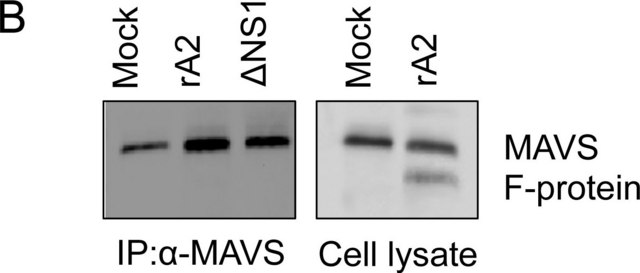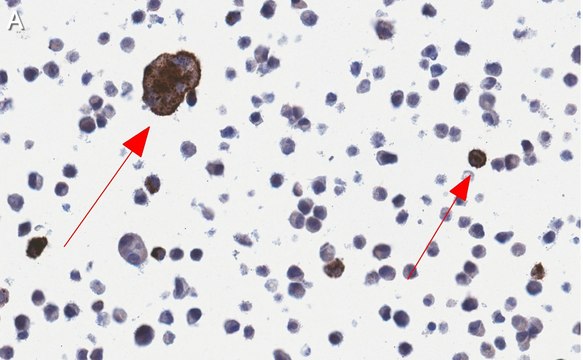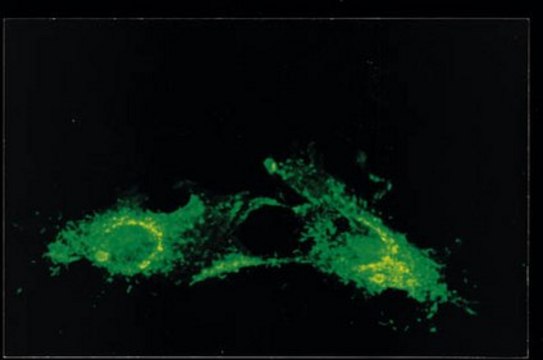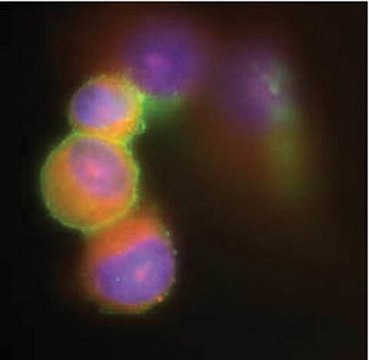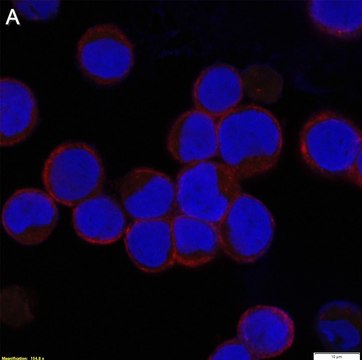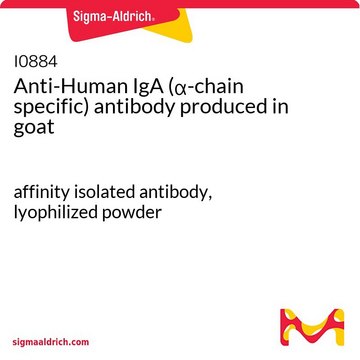MAB858-4
Anti-RSV Antibody, blend, clones 133-1H, 131-2G, and 130-12H
ascites fluid, Chemicon®, from mouse
Synonym(s):
RSV
Sign Into View Organizational & Contract Pricing
All Photos(1)
About This Item
UNSPSC Code:
12352203
eCl@ss:
32160702
NACRES:
NA.41
Recommended Products
biological source
mouse
Quality Level
antibody form
ascites fluid
antibody product type
primary antibodies
clone
130-12H, monoclonal
131-2G, monoclonal
133-1H, monoclonal
species reactivity
human
manufacturer/tradename
Chemicon®
technique(s)
ELISA: suitable
immunofluorescence: suitable
isotype
IgG
shipped in
wet ice
General description
RSV is a labile paramyxovirus that produces a characteristic fusion of human cells in tissue culture--the syncytial effect. Two subtypes, A and B, have been identified. Subtype B are characterized as the asymptomatic strains of the virus. The more severe clinical illnesses involve Subtype A strains.
Specificity
Blend of all RSV specifications of MAB858-1, 2 and 3. Recognizes the fusion, G, and nuclear protein of both A and B strains.
Immunogen
A2
Application
Anti-RSV Antibody, blend, clones 133-1H, 131-2G & 130-12H is an antibody against Respiratory Syncytial Virus for use in IF, ELISA.
ELISA at 1:800+
Indirect Immunofluorescence at 1:100-200+ (fresh frozen tissue sections)
Final working dilutions must be determined by end user.
Indirect Immunofluorescence at 1:100-200+ (fresh frozen tissue sections)
Final working dilutions must be determined by end user.
Research Category
Infectious Diseases
Infectious Diseases
Research Sub Category
Infectious Diseases - Viral
Infectious Diseases - Viral
Physical form
Liquid ascites fluid.
Unpurified
Storage and Stability
Maintain for 1 year at -20°C from date of shipment. Aliquot to avoid repeated freezing and thawing. For maximum recovery of product, centrifuge the original vial after thawing and prior to removing the cap.
Analysis Note
Control
RSV Control Slides, Catalogue Number 5012-5
RSV Control Slides, Catalogue Number 5012-5
Other Notes
Concentration: Please refer to the Certificate of Analysis for the lot-specific concentration.
Legal Information
CHEMICON is a registered trademark of Merck KGaA, Darmstadt, Germany
Disclaimer
Unless otherwise stated in our catalog or other company documentation accompanying the product(s), our products are intended for research use only and are not to be used for any other purpose, which includes but is not limited to, unauthorized commercial uses, in vitro diagnostic uses, ex vivo or in vivo therapeutic uses or any type of consumption or application to humans or animals.
Not finding the right product?
Try our Product Selector Tool.
Storage Class Code
12 - Non Combustible Liquids
WGK
nwg
Flash Point(F)
Not applicable
Flash Point(C)
Not applicable
Certificates of Analysis (COA)
Search for Certificates of Analysis (COA) by entering the products Lot/Batch Number. Lot and Batch Numbers can be found on a product’s label following the words ‘Lot’ or ‘Batch’.
Already Own This Product?
Find documentation for the products that you have recently purchased in the Document Library.
Tiina Talts et al.
Microbiology spectrum, 12(4), e0306723-e0306723 (2024-02-27)
Prevention of respiratory syncytial virus (RSV) infection is now a global health priority, with a long-acting monoclonal antibody and two RSV vaccines recently licenced for clinical use. Most licenced and candidate interventions target the RSV fusion (RSV-F) protein. New interventions
John P DeVincenzo et al.
The Journal of infectious diseases, 190(5), 975-978 (2004-08-06)
Premature infants and those with chronic lung disease or congenital heart disease are at high risk of severe respiratory syncytial virus (RSV) disease. Palivizumab (Synagis), a humanized anti-RSV monoclonal antibody, has been used extensively since 1998 to prevent severe RSV
Talita Bianca Gagliardi et al.
Intervirology, 60(1-2), 56-60 (2017-09-05)
Syncytia formation is the hallmark of the cytopathic effect caused by human respiratory syncytial virus (HRSV), which is the most important viral respiratory pathogen in children. This article reports methodological improvements in primary HRSV isolation and the importance of syncytia
Ziyin Wang et al.
Mucosal immunology, 17(2), 272-287 (2024-02-22)
Respiratory viral infections remain a major cause of hospitalization and death worldwide. Patients with respiratory infections often lose weight. While acute weight loss is speculated to be a tolerance mechanism to limit pathogen growth, severe weight loss following infection can
Hayat Caidi et al.
Methods in molecular biology (Clifton, N.J.), 1442, 13-32 (2016-07-29)
Defective interfering viral particles have been reported as important determinants of the course of viral infection, and they can markedly temper the virulence of the infection. Here, we describe a simple method, based on limiting dilution, for the removal of
Our team of scientists has experience in all areas of research including Life Science, Material Science, Chemical Synthesis, Chromatography, Analytical and many others.
Contact Technical Service